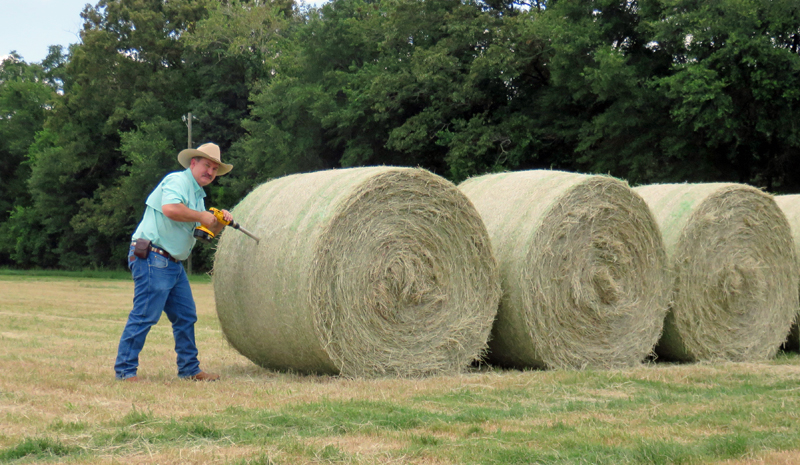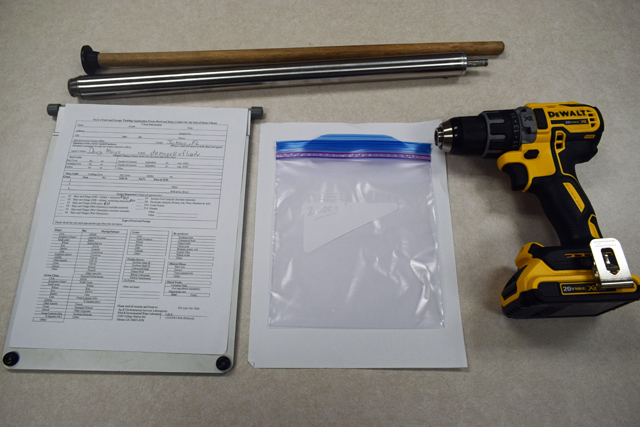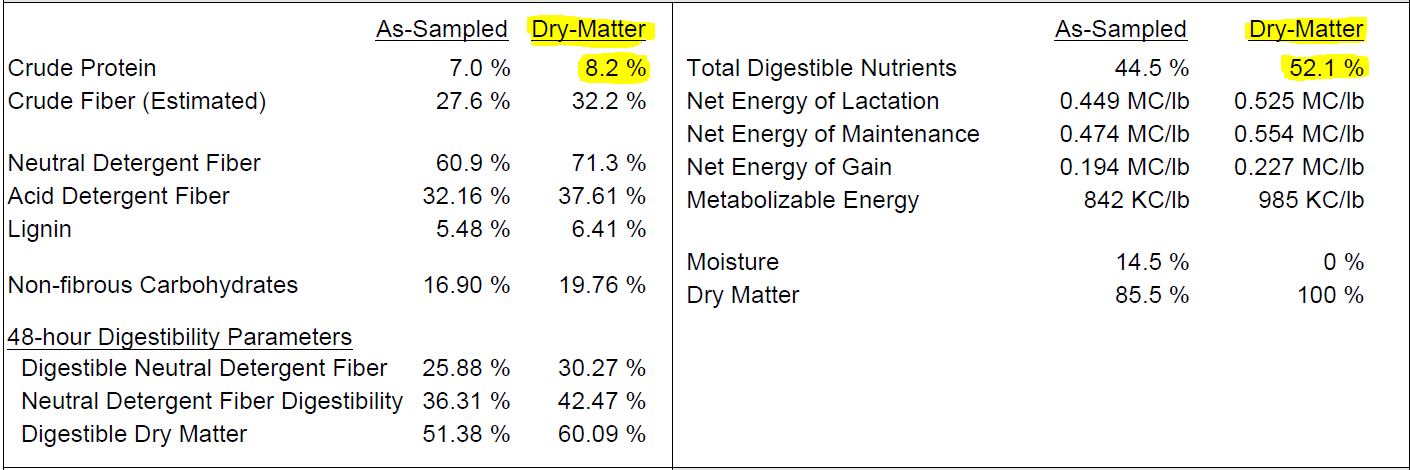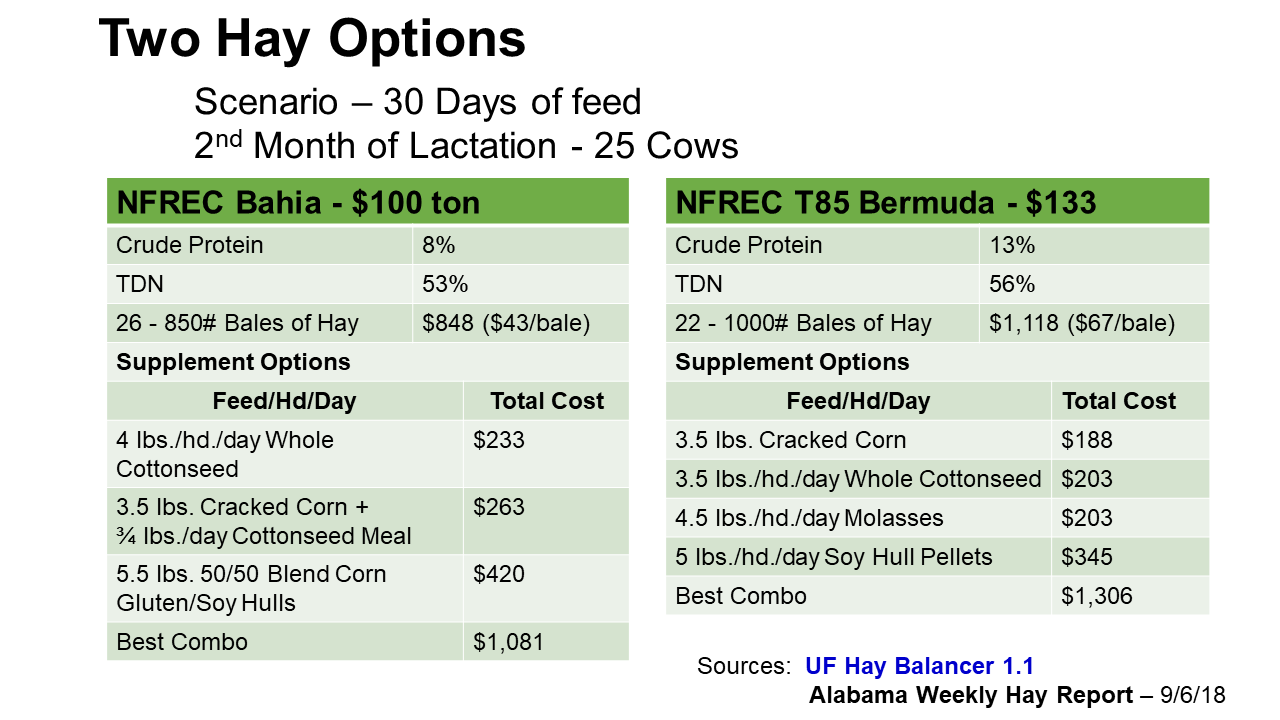
Just like soil sampling before purchasing fertilizer, hay should be sampled and sent to a lab for evaluation before purchasing supplemental feeds. As Dr. Jennifer Tucker from UGA often says, “Don’t guess, forage test!” Credit: Doug Mayo, UF/IFAS
The summer of 2018 has been very challenging for hay production. The combination of frequent rainfall, and heavy downpours have prevented timely harvest, and also diminished the quality of the hay produced. The days are getting shorter, grass growth has slowed, so it is time to start planning for cool-season supplementation. Because of the rainy summer, many producers will have to feed at least some lower quality hay this year. Since hay serves as the base for the winter feeding program on most operations, it will be even more critical this year to balance low quality hay with adequate supplemental feeds. This conundrum has many producers asking, “What is the best way to do that?”
In the modern area of precision agriculture, many crop farms have implemented the technique of precision fertilization. Using grid soil sampling, GPS maps can be generated with variable rate fertilization zones. Once the maps are paired with high-tech application equipment that responds to the data, crop farmers can fertilize more efficiently than ever before. While most livestock producers are familiar with high-tech genetic and breeding technologies, many farms are not utilizing the available technology for what I call “Precision Feeding.” Whether you produce your own hay, or buy it from a local farm or supply dealer, you should have your hay tested for nutritional quality. As Dr. Jennifer Tucker, UGA Beef Specialist, often says, “Don’t guess. Forage test!” Once you know how good or bad your hay is, you can precisely determine the type and amount of supplement needed to balance the nutritional needs of the animals you are feeding.
Forage Sampling
So where do you begin this process of fine-tuning your winter nutrition program? The first step is to sample each cutting or purchased lot of hay to determine the nutritional quality. Contact your local county agent to get some help with this. A number of the agents in the Florida Panhandle have forage probes at their office, or can get one to use from a nearby county. If you want to purchase your own equipment, there are a number of different companies that sell forage sampling probes. The one I use, was ordered from Nasco and fits on the end of a 1/2″ cordless drill. The combined cost of the forage probe ($130) and a heavy duty 1/2″ cordless drill is around $350.

To send in a forage sample to a lab for analysis you need a 1/2″ cordless drill, forage probe, and a submission form from the lab of choice. Credit: Doug Mayo, UF/IFAS
To submit a hay sample to a lab for testing, you will need to fill a 1-quart Ziploc bag with ground hay from probing 7-10 random hay bales from each cutting or purchased lots. Samples of hay from the exterior of a bale will not provide an adequate representation of the hay you will be feeding. You also don’t want to sample only a single bale. Just as with soil testing, you want to try to get a representative sample from each cutting by taking core samples from bales produced from different parts of the field. If you purchased the hay to be tested, just randomly sample from as many different bales as possible from each load.
Forage Testing
There are a number of both commercial and university forage laboratories that can be used to provide a summary of the nutritional quality of your hay. The main things you need to know are the moisture content or dry matter (%DM), crude protein (CP), and the energy level reported as total digestible nutrients (TDN). The University of Florida has a forage testing lab at the Range Cattle Research and Education Center in Central Florida, that provides a basic test for $7/sample: UF Forage Test Submission Form. You can also send in hay samples through the Southeast Hay Contest that are analyzed by the University of Georgia’s Forage Lab: SE Hay Contest Entry Form. For $22 you get the forage analysis, a nitrate level test, and may win recognition at the Sun Belt Ag Expo as one of the top forage producers in the region. The entry deadline is the third week in September each year. If you want to use a commercial service, you can also submit samples to Waters Ag Lab in Camilla, GA: Waters Feed Test Submission Form. No matter which lab you select, the goal is find out what level of protein and energy is provided by the hay, so you can calculate the level of supplemental feed needed to complement it.
Forage Analysis Results
Most all forage labs provide sample analysis results in two formats: as-sampled and dry-matter. The as-sampled column would be useful for actual ration formulation of a total mixed ration. In general though, you should focus on the dry-matter columns for comparisons between forages, and for basic supplementation calculations. Moisture levels of forages are rarely identical, so removing the moisture gives a more accurate comparison. For basic supplementation program development, you would use the highlighted dry-matter protein and energy values. If you want to know more about the other information provided in a forage test, Understanding Your Forage Test Report is an article that was published a while back that more completely explains what each of the reported values represent in a standard forage test lab report.

The forage analysis report above is fairly typical quality for average quality Bahia or low quality Bermudagrass hay that was more mature because of frequent summer rains. If you were going to feed this hay to lactating cows, or growing animals you would expect those animals to be deficient in both protein and energy. These numbers mean very little, however, without also knowing the nutrient requirements of the animals you are feeding.
Decision Aids for Supplement Calculations
There are a number of commercial software options for livestock ration balancing, as well as private nutrition consultants that provide very precise calculations for complete ration balancing. For feedlots and dairy operations, having very precise mixing recipes is essential. For most cow-calf operations, however, determining the right amounts of supplements to provide is not that complicated. Since you typically feed hay free-choice, all you really need to know is whether the hay is adequate or deficient in protein and energy. Once you know that, a simple spreadsheet can be used to provide a good estimate of the type and amount of supplement required to maintain body weight. Dr. Nicolas DiLorenzo, UF/IFAS Beef Specialist recently developed a very simple spread sheet called the UF HAY BALANCER that can be used to help cattle producers make decisions on supplement choices for mature cows on a free-choice hay diet. The University of Georgia also has a decision aid spreadsheet called the UGA BASIC BALANCER that is a little more complex, but it can be used to compare supplements for brood cows, bulls, heifers, and stockers, as well as providing some feedstuff cost comparisons. Both of these are Microsoft Excel spreadsheets that come with information pre-loaded for use. Commodity prices do fluctuate, so you may need to update the prices in the feed list provided.
Putting it All Together
In closing, I wanted to share an example of the end results of this process to demonstrate how the UF Hay Balancer can be used to help cattle producers become more precise with feeding supplements to compliment the hay they produce or purchase. For this example lets assume that you must purchase hay to feed 25 cows for 30 days that will be in their 2nd month, or peak lactation. This would be the time of most concern, because if you don’t supply adequate nutrition for these cows they will lose weight, reduce milk production, delay cycling and calve later for the following season. The following is a comparison of two types of hay at different prices, and a comparison of different supplement options. You can purchase 850 pound Bahia hay for $43 per bale or 1,000 pound Bermudagrass bales for $67 per bale (based on Alabama Weekly Hay Report). Which would be the best to purchase?

A comparison of two types of hay and the supplements needed to maintain cows at peak lactation. Source UF Hay Balancer, Alabama Weekly Hay Report and Alabama Weekly Feedstuff/Production Cost Report.
As you can see from this summary, this was not a simple scenario to answer. The end result of this exercise was that even though the bahiagrass hay was lower in quality, the cheaper price compensated for the lack of quality. The Bahia hay required a supplement that offered both protein and energy such as whole cottonseed, that can be purchased from local cotton gins, to balance the diet for these cows. The Bermudagrass hay provided adequate protein, so an energy supplement such as corn or molasses was all that required for a balanced diet. However, using 4 pounds/head/day of whole cottonseed, a rancher could feed his or her herd for 30 days cheaper with Bahia hay than with Bermudagrass hay, even though the supplement costs were $45 lower. If you had worked through this scenario with hay you have grown yourself, with similar production costs, the Bermudagrass hay would have been the better option.
If you would like assistance with forage testing, or balancing cattle herd supplementation, contact your local county extension agent. They can help you develop a precision feeding program for your herd.
- Northwest Florida Beef Cattle Conference & Trade Show – February 11 - December 19, 2025
- Friday Feature:The Sears Catalog –How Rural America Shopped before the Internet - December 19, 2025
- November 2025 Weather Summary & Winter Outlook - December 5, 2025
